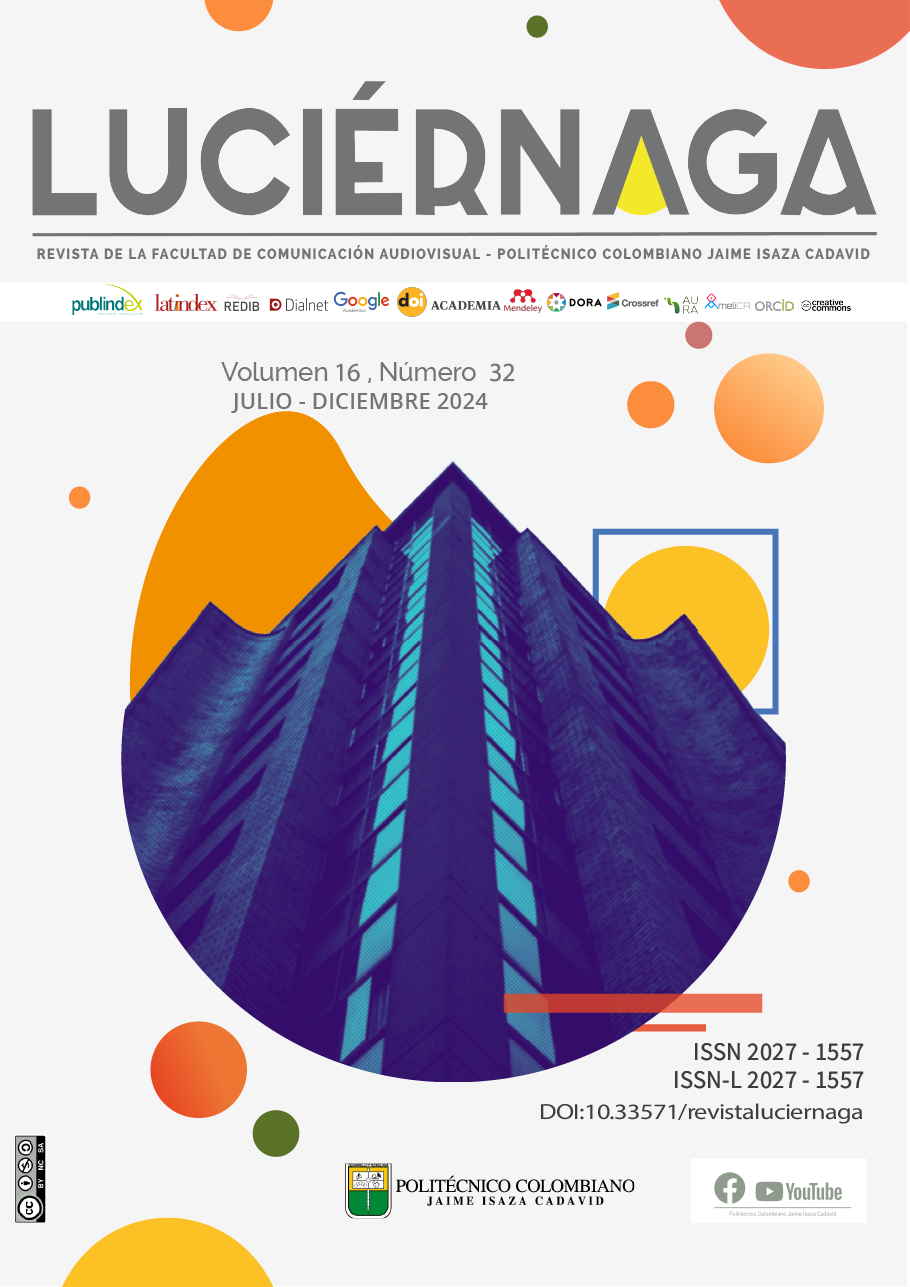La Narrativa Del Coming-Of-Age Femenino En Películas De La Empresa Cinematográfica A24
Keywords:
Coming-of-age, Feminine, Cinema, TheoryAbstract
The coming-of-age theory, which traditionally refers to the formative period from childhood to adulthood, has a primarily masculine focus. Because women's development is particular in itself, adequate tools are required for its analysis. The objective of this work is to analyze the main characteristics of the representation of women in training stages in coming-of-age films from the company A24; an indie film studio that has shown interest in young audiences and female audiences.
Through an analysis of film editing based on the theory of Vicente Sánchez-Biosca and Jean Mitry, the narrative of female coming-of-age described by Christy Rishoi in three selected films is explored: Ladybird (Ladybird, 2017), Aftersun (Aftersun, 2022) and Everything Everywhere All At Once, 2022), in which the characteristics of autofiction, the interdependence and the importance of the parental relationship, especially between mother and daughter.
Article Metrics
Abstract: 231 PDF (Español (España)): 98References
Archivo Digital de Humanidades Ervin Said. (2020). Heráclito Fragmentos. Edición Interlineal Multilingüe ADHES. https://www.mercaba.es/grecia/filosofia_de_heraclito.pdf
Benyahia, S. C., Gaffney, F. y White, J. (2006). AS Film Studies: The Essential Introduction. Routledge.
Berghahn, D. (2010). Coming of Age in the ‘the Hood’: The Diasporic Youth Film and Questions of Genre. En Berghahn, D., Sternberg, C. (eds), European Cinema in Motion (pp. 235-255). Palgrave Macmillan.
Briggs, R. (2021). “A Singular Fusion of Taste and Edge” A24 and the Indie Sector in the 2010s [tesis de maestría, The University of Texas at Austin]. Texas Scholar Works. https://repositories.lib.utexas.edu/handle/2152/87150
Castro, S. (2016). Asir lo inasible: Lenguaje y devenir en el pensamiento de Heráclito. Coris. Revista Círculo de Cartago, 12, 29-48. http://www.circulodecartago.org/wp-content/uploads/2016/09/Coris12.pdf#page=29
Cheng, A. A. (2022, 4 de mayo). 'Everything Everywhere All at Once' is a Deeply Asian American Film. The Washington Post. https://www.washingtonpost.com/outlook/2022/05/04/everything-everywhere-asian-american-pessimism/
CBS Sunday Morning. (2018). Greta Gerwig on "Lady Bird" [video]. YouTube. https://www.youtube.com/watch?v=H8H_s8sb-q4
Deadline Hollywood. (2022, 19 de septiembre). ‘Aftersun’ Director Charlotte Wells On Channeling Her Childhood Memories For Her First Feature. [video]. YouTube. https://www.youtube.com/watch?v=lKxJKuw8deI
Edwards, M. (2015). Dismantling the Genre of Female Coming-of-Age Films. Scholarship @ Claremont. https://scholarship.claremont.edu/scripps_theses/796/
Film at Lincoln Center. (2017, 30 de octubre). NYFF Live: Greta Gerwig | Lady Bird | NYFF55 [video]. YouTube. https://www.youtube.com/watch?v=wlmQfR7GWZo
García, N. C. (ed.). (2001). Tratos y retratos. Vínculos entre madre e hija. Universidad Autónoma Metropolitana. Unidad Xochimilco.
Gerwig, G. (Directora). (2017). Lady Bird [Film]. IAC Films, Scott Rudin Productions, Entertainment 360.
Gilligan, C. (2003) In a different voice: psychological theory and women's development. Harvard University Press.
Gómez, C. (2009). El Bildungsroman y la novela de formación femenina hispanoamericana contemporánea. Epos Revista de filología, (25), 107-117. https://doi.org/10.5944/epos.25.2009.10609
Hall, S. (1985). Signification, Representation, Ideology: Althusser and the post‐structuralist Debates. Critical Studies in Mass Communication, 2(2), 91-114.
Hardcastle, A., Morosini, R. y Tarte, K. (ed.). (2009). Coming of Age on Film: Stories of Transformation in World Cinema. Cambridge Scholars Publishing.
Hegel, G.W.F. (1971). Fenomenología del espíritu. Fondo de Cultura Económica.
Kaplan, L. J. (1996). Adolescencia, el adiós a la infancia. Editorial Paidos.
Kwan, D., Scheinert, D. (Directores). (2022). Everything Everywhere All At Once [Film]. A24, AGBO Production, Hotdog Hands, IAC Films, Ley Line Entertainment, Year of The Rat.
Lagos, M. (1996). En tono mayor: relatos de formación de protagonista femenina en Hispanoamérica. Editorial Cuarto Propio.
Murdock, M. (2020). Ser mujer, un viaje heroico. Gaia.
Musitano, J. (2016). La autoficción: una aproximación teórica. Entre la retórica de la memoria y la escritura de recuerdos. Acta Literaria, 52, 103-123. https://www.scielo.cl/scielo.php?script=sci_arttext&pid=S0717-68482016000100006
Mitry, J. (1978). Estética y psicología del cine. 1. Las estructuras. Siglo veintiuno editores.
Mitry, J. (1978). Estética y psicología del cine. 2. Las formas. Siglo veintiuno editores.
Mitry, J. (1990). La semiología en tela de juicio. Ediciones Akal.
Rishoi, C. (2003). From Girl to Woman. State University of New York Press.
Sánchez-Biosca, V. (1996). El montaje cinematográfico. Ediciones Paidós Ibérica.
Schmidt, M. P. (2002, mayo). Coming of Age in American Cinema: Modern Youth Films as Genre. University of Massachusetts Amherst. https://scholarworks.umass.edu/dissertations/AAI3056276/
Tacca, O. (1973). Las voces de la novela. Editorial Gredos.
The Hollywood Reporter. (2022, 17 de septiembre). Paul Mescal & ‘Aftersun’ Director Charlotte Wells on the Emotional Reaction to the Film | TIFF 2022. [video]. YouTube. https://www.youtube.com/watch?v=-w0-81tmEJg
Tolchin, K. (2007). Part Blood, Part Ketchup. Lexington Books.
Wells, C. (Directora). (2022). Aftersun [Film]. BBC Film, British Film Institute (BFI), Screen Scotland.
Yamato, J. (2022, abril). ‘Everything Everywhere All at Once’ explained: Hot dog hands, empathy challenges and meaning in the absurd. Los Angeles Times. https://www.latimes.com/entertainment-arts/movies/story/2022-04-14/everything-everywhere-all-at-once-explained-daniels-spoilers
Zaá, J. (2021). El ser en devenir. Una aproximación filosófica. Revista Visión Educativa, Universidad Bicentenaria de Aragua, 3(1), 75-82. http://uba.edu.ve/wp-content/uploads/2021/04/REVISTA-VISION-EDUCATIVA-VOL-3-N%C2%B0-1-02-04-2021.pdf#page=75
Downloads
Published
How to Cite
Issue
Section
License
Copyright (c) 2024 Melisa Alejandra González Aguirre

This work is licensed under a Creative Commons Attribution-NonCommercial-ShareAlike 4.0 International License.
Aquellos autores/as que tengan publicaciones con esta revista, aceptan los términos siguientes:- Los autores/as conservarán sus derechos de autor y garantizarán a la revista el derecho de primera publicación de su obra, el cuál estará simultáneamente sujeto a una licencia de Creative Commons Atribución – No comercial – Compartir igual
que permite a terceros compartir la obra siempre que se indique su autor y su primera publicación en esta revista. - Los autores/as podrán adoptar otros acuerdos de licencia no exclusiva de distribución de la versión de la obra publicada (p. ej.: depositarla en un archivo telemático institucional o publicarla en un volumen monográfico) siempre que se indique la publicación inicial en esta revista.
- Se permite y recomienda a los autores/as difundir su obra a través de Internet (p. ej.: en archivos telemáticos institucionales o en su página web) antes y durante el proceso de envío, lo cual puede producir intercambios interesantes y aumentar las citas de la obra publicada. (Véase El efecto del acceso abierto)
- Luciérnaga-Comunicación no cobra tasas o cargos a Autores o colaradores por la recepción, revisión o publicación de artículos (APC -Article Processing Charges/ publication fee).













